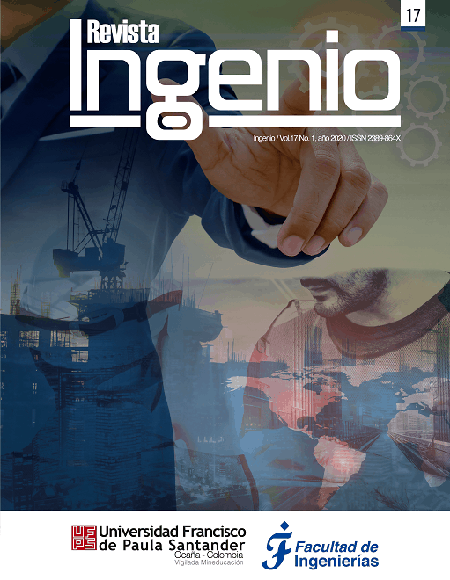Cálculo de propiedades de combustión y análisis de estabilidad de llama para el gas límite 65%CH4 + 35%H2
Calculation of combustion properties and flame stability analysis for the limit gas 65%CH4 + 35%H2
Contenido principal del artículo
La demanda de energía mundial potencia los beneficios ambientales y operacionales del gas natural como alternativa energética, por su composición, principalmente metano (CH4), presenta bajas emisiones contaminantes y beneficios en sistemas energéticos y combustión; de ahí que se busquen mezclas de gas natural con otros combustibles, como hidrógeno (H2), para potenciar aún más sus propiedades. En el presente trabajo se determinaron numérica y experimentalmente algunas propiedades para la mezcla 65 % CH4 + 35 % H2 a condiciones atmosféricas de la ciudad de Medellín, Colombia, propiedades relacionadas con la estructura, estabilidad de la llama, y autoignición. Simulaciones numéricas y mediciones experimentales de la velocidad de deflagración laminar se realizaron para dosados entre 0.9 y 1.4. En general la velocidad de deflagración laminar se ajusta de buena forma a los resultados numéricos, el valor máximo de la velocidad de deflagración corresponde a un valor de 51.38 cm/s para un dosado de 1.1. Para un dosado de 0.75 se presentan inestabilidades de llama. Adicionalmente, se encontró que el rango optimo de operación del quemador operando con este gas límite es en el rango de dosados relativo entre 0.9<- 0 <-1.4.
Descargas
Datos de publicación
Perfil evaluadores/as N/D
Declaraciones de autoría
Indexado en
- Sociedad académica
- Universidad Francisco de Paula Santander
- Editorial
- Universidad Francisco de Paula Santander
Detalles del artículo
K. Zhao, D. Cui, T. Xu, Q. Zhou, S. Hui, and H. Hu, “Effects of hydrogen addition on methane combustion,” Fuel Process. Technol., vol. 89, no. 11, pp. 1142–1147, Nov. 2008, doi: http://dx.doi.org/10.1016/j.fuproc.2008.05.005. DOI: https://doi.org/10.1016/j.fuproc.2008.05.005
C. Serrano, J. J. Hernández, C. Mandilas, C. G. W. Sheppard, and R. Woolley, “Laminar burning behaviour of biomass gasification-derived producer gas,” Int. J. Hydrogen Energy, vol. 33, no. 2, pp. 851–862, 2008, doi: http://dx.doi.org/10.1016/j.ijhydene.2007.10.050. DOI: https://doi.org/10.1016/j.ijhydene.2007.10.050
R. J. Kee et al., “The PREMIX program is part of the CHEMKIN Collection. CHEMKIN Collection, Release 3.6,” 2000.
G. P. Smith et al., “Gri-Mech 3.0.” http://www.me.berkeley.edu/gri_mech/.
L. Elliott, D. B. Ingham, A. G. Kyne, N. S. Mera, M. Pourkashanian, and C. W. Wilson, “Genetic algorithms for optimisation of chemical kinetics reaction mechanisms,” Prog. Energy Combust. Sci., vol. 30, no. 3, pp. 297–328, 2004, doi: 10.1016/j.pecs.2004.02.002. DOI: https://doi.org/10.1016/j.pecs.2004.02.002
H. J. Burbano, J. Pareja, and A. A. Amell, “Laminar burning velocities and flame stability analysis of H2/CO/air mixtures with dilution of N2 and CO2,” Int. J. Hydrogen Energy, vol. 36, no. 4, pp. 3232–3242, 2011, doi: http://dx.doi.org/10.1016/j.ijhydene.2010.11.089. DOI: https://doi.org/10.1016/j.ijhydene.2010.11.089
G. I. Sivashinsky, “Instabilities, Pattern Formation, and Turbulence in Flames,” Annu. Rev. Fluid Mech., vol. 15, no. 1, pp. 179–199, Jan. 1983, doi: 10.1146/annurev.fl.15.010183.001143. DOI: https://doi.org/10.1146/annurev.fl.15.010183.001143
J. Yuan, Y. Ju, and C. K. Law, “On flame-front instability at elevated pressures,” Proc. Combust. Inst., vol. 31, no. 1, pp. 1267–1274, Jan. 2007, doi: 10.1016/j.proci.2006.07.180. DOI: https://doi.org/10.1016/j.proci.2006.07.180
C. Tang, X. Man, L. Wei, L. Pan, and Z. Huang, “Further study on the ignition delay times of propane–hydrogen–oxygen–argon mixtures: Effect of equivalence ratio,” Combust. Flame, vol. 160, no. 11, pp. 2283–2290, Nov. 2013, doi: 10.1016/j.combustflame.2013.05.012. DOI: https://doi.org/10.1016/j.combustflame.2013.05.012
M. Lamnaouer, R. C. Ryder, A. Brankovic, and E. L. Petersen, “Reduced combustion time model for methane in gas turbine flow fields,” J. Nat. Gas Chem., vol. 18, no. 2, pp. 145–155, Jun. 2009, doi: 10.1016/S1003-9953(08)60093-6. DOI: https://doi.org/10.1016/S1003-9953(08)60093-6
Y. Zhang, Z. Huang, L. Wei, J. Zhang, and C. K. Law, “Experimental and modeling study on ignition delays of lean mixtures of methane, hydrogen, oxygen, and argon at elevated pressures,” Combust. Flame, vol. 159, no. 3, pp. 918–931, 2012, doi: 10.1016/j.combustflame.2011.09.010. DOI: https://doi.org/10.1016/j.combustflame.2011.09.010
A. Amell, “Fenómenos de combustión en llamas de premezcla.” Grupo de Ciencia y Tecnología del Gas y Uso Racional de la Energía, GASURE, Facultad de Ingeniería, Universidad de Antioquia, Medellín, 2009.
J. Huang and W. K. Bushe, “Experimental and kinetic study of autoignition in methane/ethane/air and methane/propane/air mixtures under engine-relevant conditions,” Combust. Flame, vol. 144, no. 1–2, pp. 74–88, 2006, doi: http://dx.doi.org/10.1016/j.combustflame.2005.06.013. DOI: https://doi.org/10.1016/j.combustflame.2005.06.013
A. Cardona Vargas, A. Amell Arrieta, and C. E. Arrieta, “Combustion characteristics of several typical shale gas mixtures,” J. Nat. Gas Sci. Eng., vol. 33, pp. 296–304, 2016, doi: 10.1016/j.jngse.2016.03.039. DOI: https://doi.org/10.1016/j.jngse.2016.03.039
F. E. & C. K. L. Hai Wang, Xiaoqing You, Ameya V. Joshi, Scott G. Davis, Alexander Laskin, “USC Mech Version II. High-Temperature Combustion Reaction Model of H2/CO/C1-C4 Compounds.” 2007.
H. Bongers and L. P. H. De Goey, “The effect of simplified transport modeling on the burning velocity of laminar premixed flames,” Combust. Sci. Technol., vol. 175, no. 10, pp. 1915–1928, 2003, doi: 10.1080/713713111. DOI: https://doi.org/10.1080/713713111
C. A. Cardona, “Determinación numérica y experimental de la velocidad de deflagración laminar y patrón de radiación de la mezcla equimolar de gas natural y gas de síntesis con aire normal y aire enriquecido con oxígeno,” Universidad de Antioquia, Medellín, 2012.
V. Disarli and a Benedetto, “Laminar burning velocity of hydrogen–methane/air premixed flames,” Int. J. Hydrogen Energy, vol. 32, no. 5, pp. 637–646, Apr. 2007, doi: 10.1016/j.ijhydene.2006.05.016. DOI: https://doi.org/10.1016/j.ijhydene.2006.05.016









